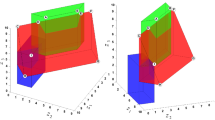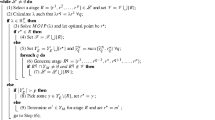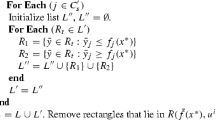Abstract
This paper presents a new technique to compute nondominated solutions in multiobjective linear-fractional programming (MOLFP) by using reference points. The basic idea consists in dividing the nondominated region approximately through the “middle” making two subregions, which are then analyzed in order to try to discard one of them. The process is repeated with the remaining region(s), and it ends when the regions become so small that the differences among their nondominated solutions are lower than a predefined margin of error. The results of several tests carried out to evaluate the performance of the technique are reported.
Similar content being viewed by others
References
M. J. Alves and J. Clímaco, “Using cutting planes in an interactive reference point approach for multiobjective integer linear programming problems,” Eur. J. Oper. Res., 117, 565–577 (1999).
S. Birbil, J. Frenk, and S. Zhang, “Generalized fractional programming with user interaction,” ERIM Report Ser. Res. Management, ERS-2004-033-LIS, Erasmus Research Institute of Management (2004).
A. Charnes and W. Cooper, “Programming with linear fractional functions,” Nav. Res. Logist. Q., 9, 181–186 (1962).
J. Costa, “Computing nondominated solutions in MOLFP,” Eur. J. Oper. Res., 181, 1464–1475 (2007).
J. Costa and J. Clímaco, “Relating reference points and weights in multiobjective linear programming,” J. Multi-Criteria Decision Anal., 8, 281–290 (1999).
J. Ferland and J. Y. Potvin, “Generalized fractional programming: algorithms and numerical experimentations,” Eur. J. Oper. Res., 20, 92–101 (1985).
J. Frenk and S. Schaible, “Fractional programming,” ERIM Report Series Research in Management, ERS-2004-074-LIS, Erasmus Research Institute of Management (2004).
R. Freund and F. Jarre, “Solving the sum-of-ratios problem by an interior-point method,” J. Global Optim., 19, 83–102 (2001).
M. Goedhart and J. Spronk, “Financial planning with fractional goals,” Eur. J. Oper. Res., 82, 111–124 (1995).
J. Kornbluth and R. Steuer, “Goal programming with linear fractional criteria,” Eur. J. Oper. Res., 8, 58–65 (1981).
J. Kornbluth and R. Steuer, “Multiple objective linear fractional programming,” Manag. Sci., 27, 1024–1039 (1981).
T. Kuno, “A branch-and-bound algorithm for maximizing the sum of several linear ratios,” J. Global Optim., 22, 155–174 (2002).
B. Metev and D. Gueorguieva, “A simple method for obtaining weakly efficient points in multiobjective linear fractional programming problems,” Eur. J. Oper. Res., 126, 386–390 (2000).
S. Schaible, “Fractional programming: applications and algorithms,” Eur. J. Oper. Res., 7, 111–120 (1981).
I. Stancu-Minasian, Fractional Programming: Theory, Methods and Applications, Kluwer Academic Publishers, Dordrecht (1997).
R. Steuer, Multiple Criteria Optimization: Theory, Computation and Application, Wiley, New York (1986).
A. Wierzbicki, “The use of reference points in multiobjective optimization,” In: Multiple Criteria Decision Making, Theory and Application (G. Fandel and T. Gal, eds.), Springer-Verlag (1980), pp. 468–486.
A. Wierzbicki, Reference Point Methods in Vector Optimization and Decision Support, Interim Report, IIASA, IR-98-017, Laxenburg (1998).
Author information
Authors and Affiliations
Corresponding author
Additional information
Translated from Sovremennaya Matematika i Ee Prilozheniya (Contemporary Mathematics and Its Applications), Vol. 63, Optimal Control, 2009.
Rights and permissions
About this article
Cite this article
Costa, J.P., Alves, M.J. A reference point technique to compute nondominated solutions in MOLFP. J Math Sci 161, 820–831 (2009). https://doi.org/10.1007/s10958-009-9603-z
Published:
Issue Date:
DOI: https://doi.org/10.1007/s10958-009-9603-z




